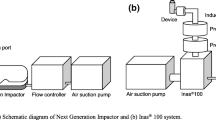Abstract
Purpose. The purpose of the work is to study the adsorption of Oleic acid and Span 85 (materials frequently used in aerosols as surfactants) onto partially amorphous and essentially crystalline salbutamol sulphate, attempting to understand the behaviour of metered dose inhalers (MDIs) and observing whether there were any differences in adsorption behaviour and if this could be related to the surface properties of the powder.
Methods. Isothermal titration microcalorimetry was the principal technique used to measure the adsorption behaviour of surfactants to salbutamol sulphate. A Malvern particle size analyzer was also employed to provide size data on the interactions between the surfactant and powder suspensions.
Results. The calorimetric data revealed that surfactant adsorption to the crystalline micronised powder (78% RH and aged dry sample) produced significant exotherms, whereas adsorption to the partially amorphous micronised powder resulted in small heat responses. The differences in adsorption behaviour to the partially crystalline and crystalline surfaces resulted in changes in aggregation behaviour.
Conclusions. The stability of MDIs varies depending on the water content, crystallinity and surface composition of the powder. The advantages of using isothermal titration microcalorimetry to evaluate this surface behaviour in such difficult systems was demonstrated.
Similar content being viewed by others
REFERENCES
B. K. Sidhu, C. Washington, S. S. Davis and T. S. Purewell. Electrophoretic properties of lactose and salbutamol sulphate suspensions in halogenated solvents. Langmuir, 9:839–843 (1993).
F. X. Fischer, H. Hess, H. Sucker and P. R. Byron. CFC propellant substitution: international perspectives. Pharmaceutical Technology International, 1:16–18 (1989).
R. N. Dalby, P. R. Byron, H. R. Shepherd and E. Papadopoulos. CFC propellant substitution: P-134a as a potential replacement for P-12 in MDIs. Pharmaceutical Technology International, 2:26–33 (1990).
L-E. Briggner, G. Buckton, K. Bystrom and P. Darcy. The use of isothermal microcalorimetry in the study of changes in crystallinity induced during the processing of powders. Int. J. Pharm., 105:125–135 (1994).
R. Hüttenrauch, S. Fricke and P. Zielke. Mechanical activation of pharmaceutical systems. Pharm. Res., 2:302–306 (1985).
T. Sebhatu, M. Angberg and C. Ahlneck. Assessment of the degree of disorder in crystalline solids by isothermal microcalorimetry. Int. J. Pharm., 104:135–144 (1994b).
A. A. Elamin, T. Sebhatu and C. Ahlneck. The use of amorphous model substances to study mechanically activated materials in the solid state. Int. J. Pharm., 119:25–36 (1995).
A. Saleki-Gerhardt and G. Zografi. Non-isothermal crystallization of sucrose from the amorphous state. Pharm. Res., 11: 1166–1173 (1985).
A. Chawla, G. Buckton, K. M. G. Taylor, J. M. Newton and M. C. R. Johnson. Wilhelmy plate contact angle data on powder compacts: considerations of plate perimeter. Eur. J. Pharm. Sci., 2:253–258 (1994).
G. Buckton, P. Darcy, D. Greenleaf and P. Holbrook. The use of isothermal microcalorimetry in the study of changes in crystallinity of spray-dried salbutamol sulphate. Int. J. Pharm., 116:113–118 (1995).
D. L. Ross, R. K. Schultz and L. L. Ishola. Effect of particle size reduction technique on the crystal growth of MDI suspension formulations. Pharm. Res. Suppl. Nov, AAPS abstract No. PT6123 (1993).
L-E. Briggner and I. Wadsö. Test and calibration processes for microcalorimeters, with special reference to heat conduction instruments used with aqueous systems. J. Biochem. Biophys., 22:101–118 (1991).
G. Buckton, P. Darcy and A. J. MacKellar. The use of isothermal microcalorimetry in the study of small degrees of amorphous content of powders. Int. J. Pharm., 117:253–256 (1995).
Author information
Authors and Affiliations
Rights and permissions
About this article
Cite this article
Blackett, P.M., Buckton, G. A Microcalorimetric Investigation of the Interaction of Surfactants with Crystalline and Partially Crystalline Salbutamol Sulphate in a Model Inhalation Aerosol System. Pharm Res 12, 1689–1693 (1995). https://doi.org/10.1023/A:1016257504115
Issue Date:
DOI: https://doi.org/10.1023/A:1016257504115




